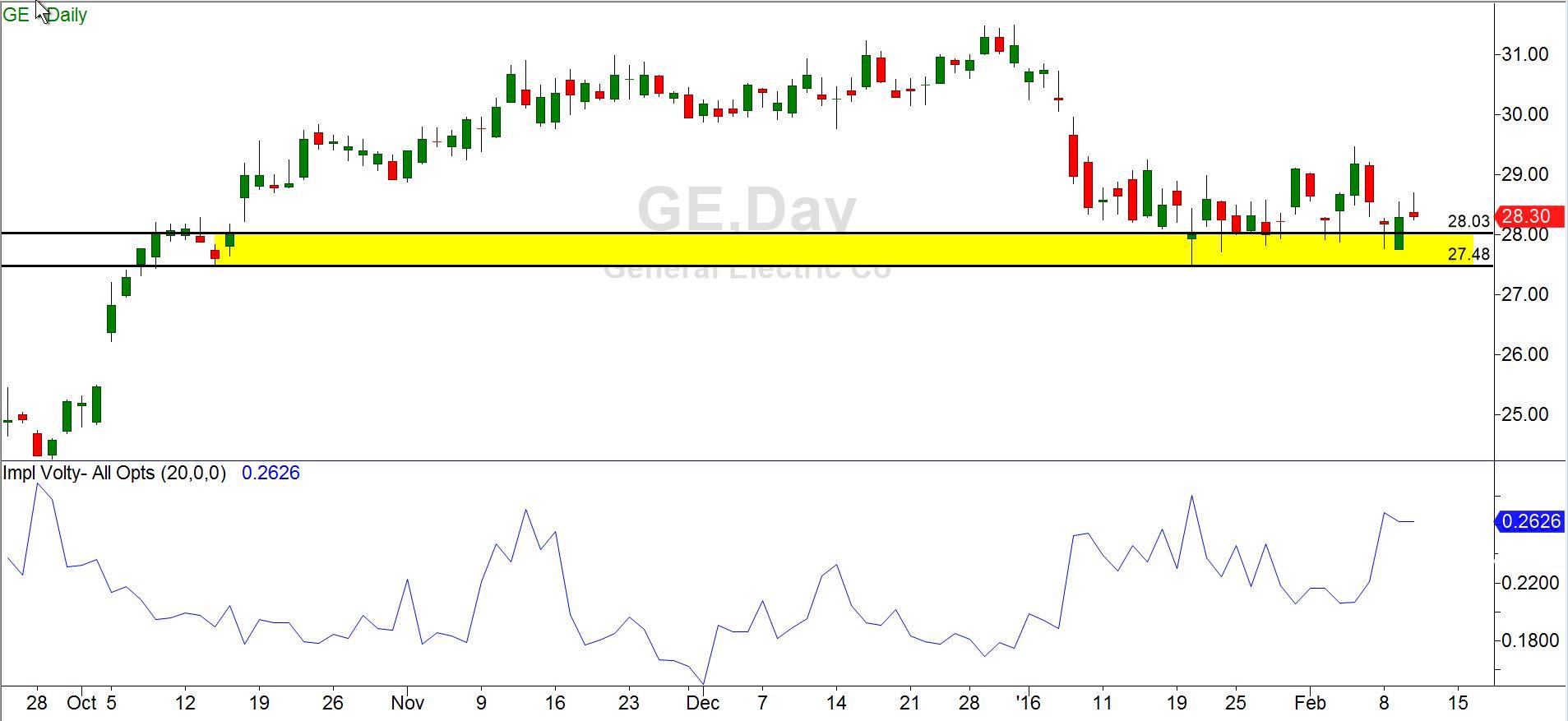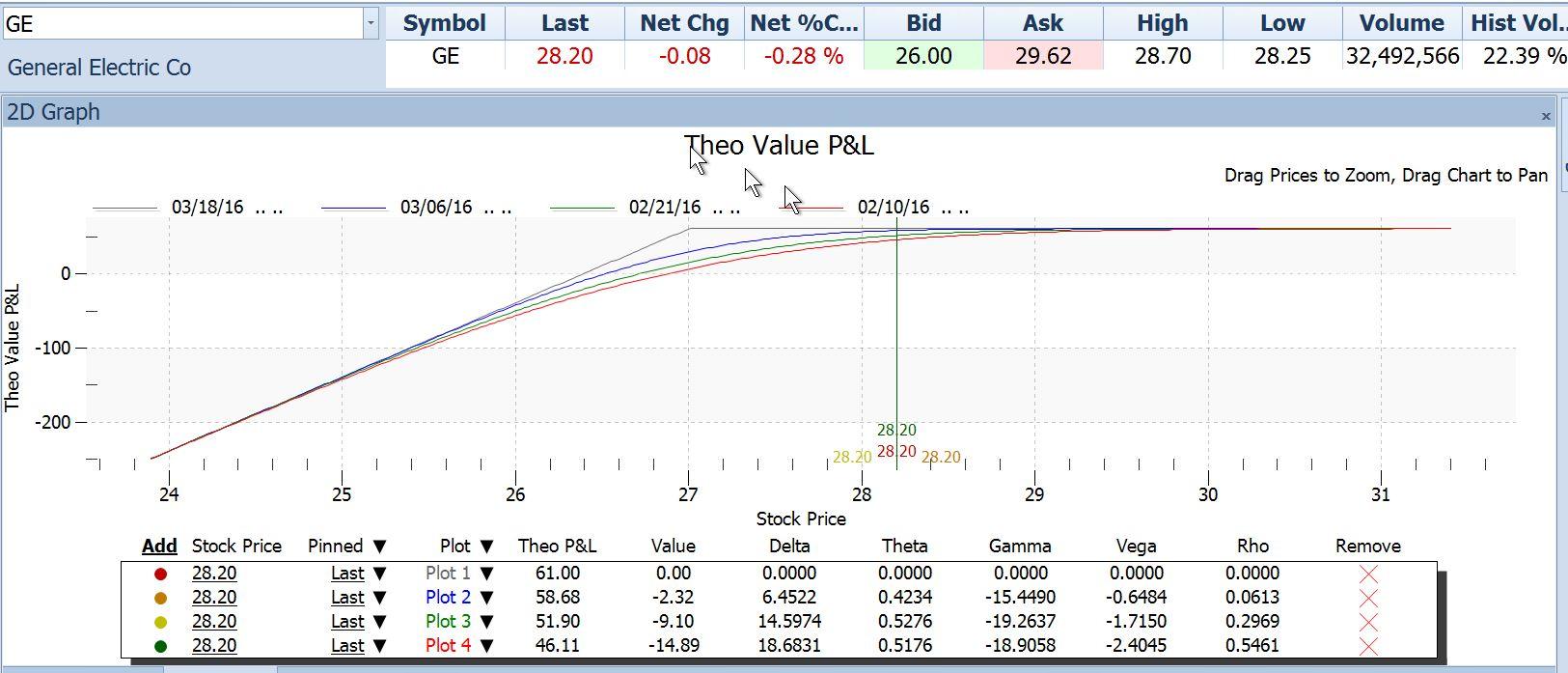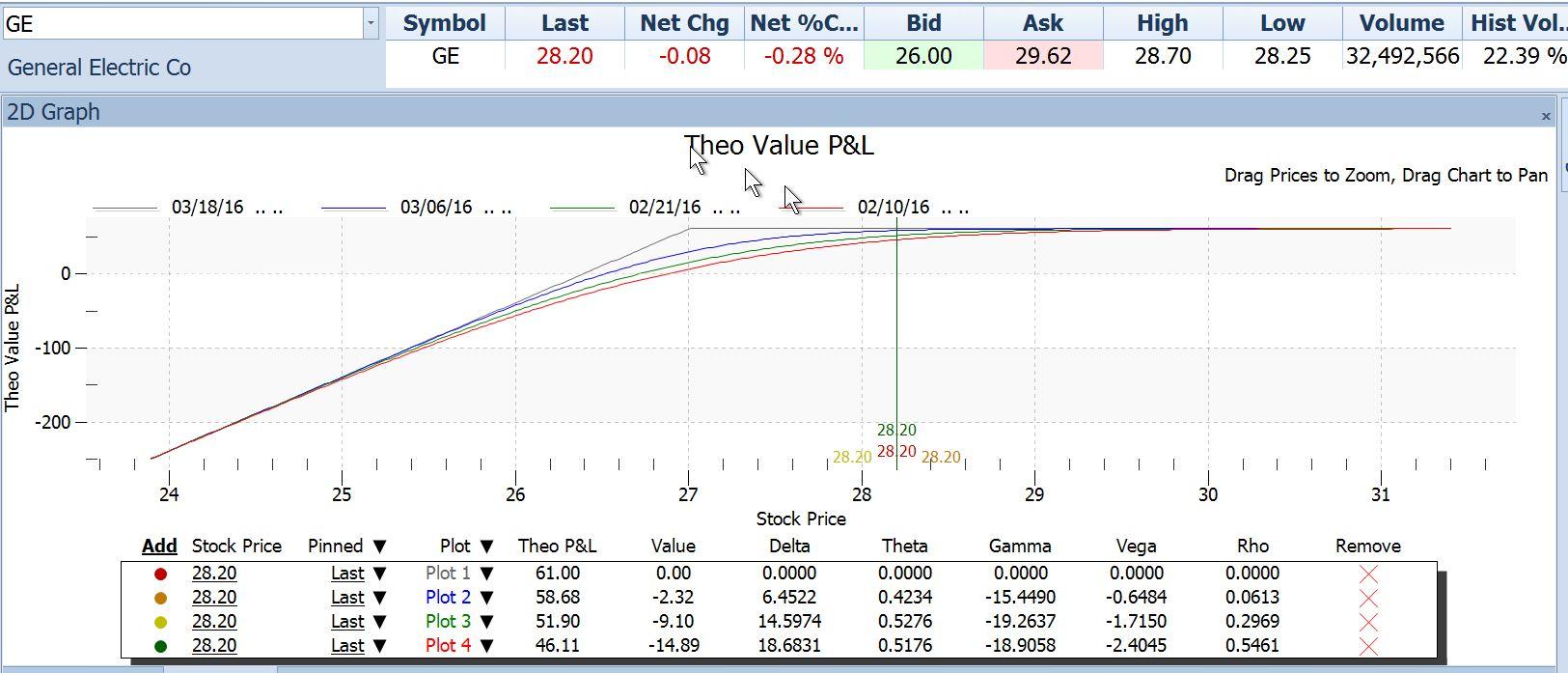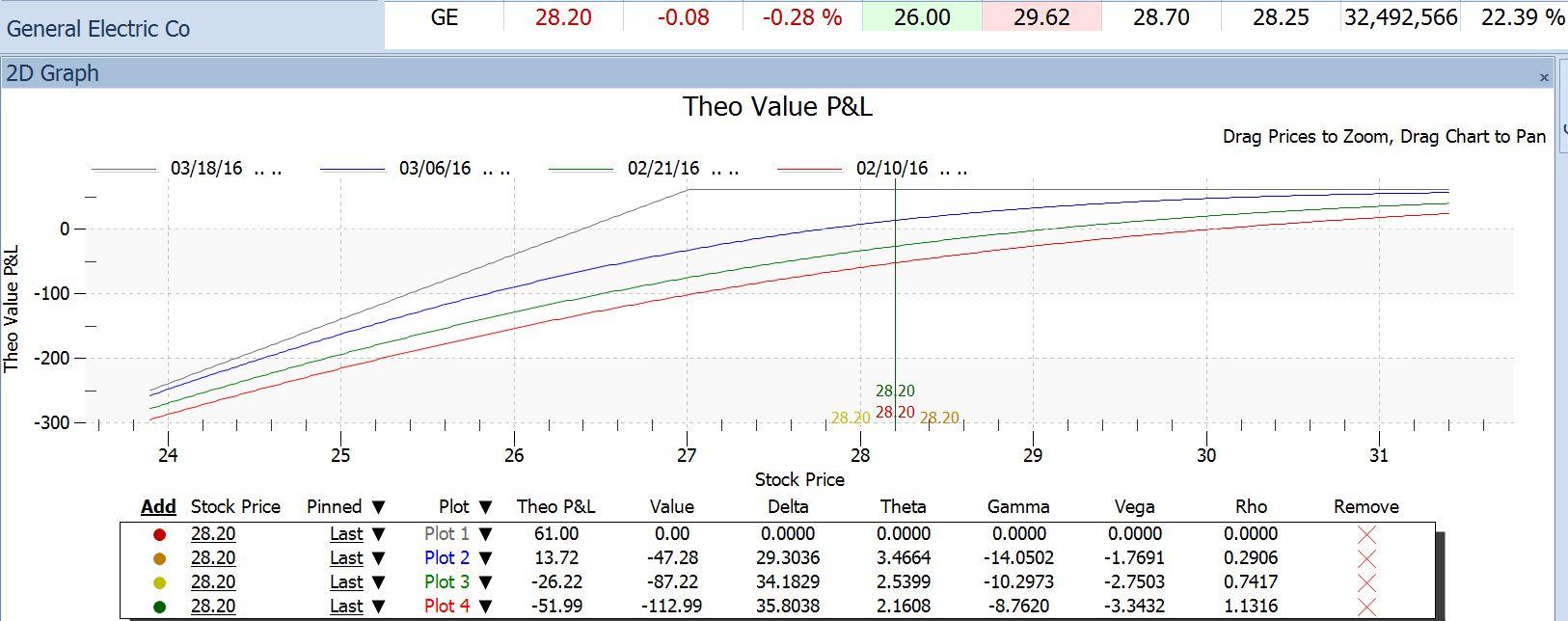This series of articles has covered the use of the Option Payoff Graph as a trade analysis tool for option trades. We’ve used an example that involved selling (short) put options on GE stock.
When the series began several weeks ago, it appeared that GE was likely to hold above the $27 level through the February options expiration date. Using this trade analysis tool, we investigated selling puts at the $27 strike.
Below is the way GE’s stock looked as of this writing on February 10. This final article in this series will examine how the option payoff graph depicts possible changes in market expectations, otherwise known as Implied Volatility.
I should say here that the bullish case for GE did not look nearly as strong on February 10 as it had when we first suggested it on January 19. At that time, we sold the $27-strike puts for $60 per contract, expecting GE to rally. GE did in fact hold above our $27 strike price, and the February puts were then just $19 per contract, showing a nice profit of $41 per contract.
But the stock did not take the kind of bounce that we were hoping for. This is not surprising since the general market direction has been very bearish. Nevertheless, for the sake of continuity we’ll finish out our example with this same stock, re-setting it to use the March $27 options.
As of February 10, the March puts at the $27 strike price were around $61 per contract. They had 36 days until expiration. For a short put position, the following option payoff graph shows the projected P/L at four different dates – 0 days to go, 12 days, 24 days and 36 days.
Option Payoff Graph – Volatility constant
Let’s take a look at the four different colored lines above for our trade analysis. They demonstrate how we can visualize the profit picture at different dates in the future, at any price for the stock. The red line is how things looked on Feb 10, with 36 days to go. The green line is how they would look 12 days later, the blue line 12 days after that and the gray line as of the expiration date on March 18.
All of those lines were drawn assuming that the expectations of volatility for the stock remained unchanged. This is the default assumption. But we also would like to know how things would be affected by a change in expectations. What if option buyers decided that they now believed the stock would move 50% faster than they had previously thought? How much more would they be charging us to buy those options back in that case? And what if, on the other hand, they expected the stock to move 50% slower than they had thought? How much cheaper would those options be?
The payoff graph can help us with this part of the trade analysis as well. By working those changes in assumptions into the payoff graph, we can see the subtle differences in the projected outcome. Compare the payoff graphs below to the first one:
Option Payoff Graph – Volatility reduced by 50%
Notice above that all of the curved lines are higher at every stock price – a reduction in volatility after we have sold puts and pocketed the money increases our profit.
Option Payoff Graph – Volatility increased by 50%
Here, on the other hand, we see how an increase in volatility would reduce our profits at any date and stock price. That is because if volatility increased, the price we might have to pay to buy the option back and terminate the trade would increase, reducing our profit.
If we had a strong expectation that the level of implied volatility would either rise (because it was abnormally low) or fall (because it was abnormally high), then being able to model those expected changes would allow us to quantify the effect.
In this series of articles, we’ve shown that the option payoff graph can be used to forecast the effect on any option position for all three of the main forces that affect them: stock price, time and volatility. For option traders, the effort spent learning to use this invaluable trade analysis tool is well worth it.
This content is intended to provide educational information only. This information should not be construed as individual or customized legal, tax, financial or investment services. As each individual's situation is unique, a qualified professional should be consulted before making legal, tax, financial and investment decisions. The educational information provided in this article does not comprise any course or a part of any course that may be used as an educational credit for any certification purpose and will not prepare any User to be accredited for any licenses in any industry and will not prepare any User to get a job. Reproduced by permission from OTAcademy.com click here for Terms of Use: https://www.otacademy.com/about/terms
Editors’ Picks
EUR/USD clings to daily gains above 1.0650

EUR/USD gained traction and turned positive on the day above 1.0650. The improvement seen in risk mood following the earlier flight to safety weighs on the US Dollar ahead of the weekend and helps the pair push higher.
GBP/USD recovers toward 1.2450 after UK Retail Sales data

GBP/USD reversed its direction and advanced to the 1.2450 area after touching a fresh multi-month low below 1.2400 in the Asian session. The positive shift seen in risk mood on easing fears over a deepening Iran-Israel conflict supports the pair.
Gold holds steady at around $2,380 following earlier spike

Gold stabilized near $2,380 after spiking above $2,400 with the immediate reaction to reports of Israel striking Iran. Meanwhile, the pullback seen in the US Treasury bond yields helps XAU/USD hold its ground.
Bitcoin Weekly Forecast: BTC post-halving rally could be partially priced in Premium

Bitcoin price shows no signs of directional bias while it holds above $60,000. The fourth BTC halving is partially priced in, according to Deutsche Bank’s research.
Week ahead – US GDP and BoJ decision on top of next week’s agenda

US GDP, core PCE and PMIs the next tests for the Dollar. Investors await BoJ for guidance about next rate hike. EU and UK PMIs, as well as Australian CPIs also on tap.
RECOMMENDED LESSONS
Making money in forex is easy if you know how the bankers trade!
Discover how to make money in forex is easy if you know how the bankers trade!
5 Forex News Events You Need To Know
In the fast moving world of currency markets, it is extremely important for new traders to know the list of important forex news...
Top 10 Chart Patterns Every Trader Should Know
Chart patterns are one of the most effective trading tools for a trader. They are pure price-action, and form on the basis of underlying buying and...
7 Ways to Avoid Forex Scams
The forex industry is recently seeing more and more scams. Here are 7 ways to avoid losing your money in such scams: Forex scams are becoming frequent. Michael Greenberg reports on luxurious expenses, including a submarine bought from the money taken from forex traders. Here’s another report of a forex fraud. So, how can we avoid falling in such forex scams?
What Are the 10 Fatal Mistakes Traders Make
Trading is exciting. Trading is hard. Trading is extremely hard. Some say that it takes more than 10,000 hours to master. Others believe that trading is the way to quick riches. They might be both wrong. What is important to know that no matter how experienced you are, mistakes will be part of the trading process.




